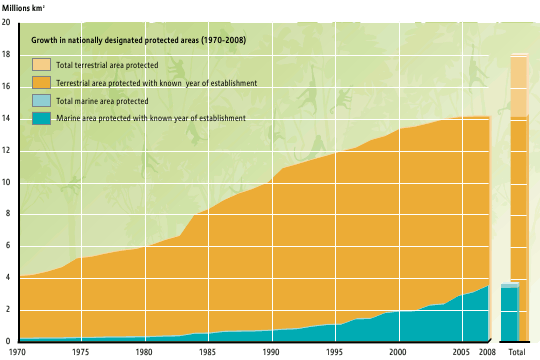Addressing Biodiversity Loss
Author and Page information
This print version has been auto-generated from https://www.globalissues.org/article/787/addressing-biodiversity-loss
 At the 1992 UN Conference on Environment and Development (the
At the 1992 UN Conference on Environment and Development (the Earth Summit
), the Convention on Biological Diversity1 (CBD) was born.
192 countries, plus the EU, are now Parties to that convention. In April 2002, the Parties to the Convention committed to significantly reduce the loss of biodiversity loss by 2010.
On this page:
Biodiversity 2010 target not met
Perhaps predictably, meeting the 2010 target did not happen.
As the Global Biodiversity Outlook 33 report summarizes, despite numerous successful conservations measures supporting biodiversity, none of the specific targets were met, and biodiversity losses continue.
In addition, despite an increase in conservation efforts, the state of biodiversity continues to decline, according to most indicators, largely because the pressures on biodiversity continue to increase. There is no indication of a significant reduction in the rate of decline in biodiversity, nor of a significant reduction in pressures upon it.
(p.17)
Furthermore,
Action to implement the Convention on Biological Diversity has not been taken on a sufficient scale to address the pressures on biodiversity in most places. There has been insufficient integration of biodiversity issues into broader policies, strategies and programmes, and the underlying drivers of biodiversity loss have not been addressed significantly. Actions to promote … biodiversity receive a tiny fraction of funding compared to … infrastructure and industrial developments. Moreover, biodiversity considerations are often ignored when such developments…. Actions to address the underlying drivers of biodiversity loss, including demographic, economic, technological, socio-political and cultural pressures, in meaningful ways, have also been limited.
…
Most future scenarios project continuing high levels of extinctions and loss of habitats throughout this century, with associated decline of some ecosystem services important to human well-being.
Most indicators of the state of biodiversity show negative trends, with no significant reduction in the rate of decline:

An example of the positive efforts has been the growth in protected areas in recent years, including more protected marine areas:

However, the level of protection in protected areas is mostly basic:
Despite more than 12 per cent of land now being covered by protected areas, nearly half (44%) of terrestrial eco-regions fall below 10 per cent protection, and many of the most critical sites for biodiversity lie outside protected areas. Of those protected areas where effectiveness of management has been assessed, 13% were judged to be clearly inadequate, while more than one fifth demonstrated sound management, and the remainder were classed as
basic.
Putting an economic value on biodiversity
In the biodiversity section8, it is noted that ecosystems provide us many services, for free.
Although some dislike the thought of trying to put an economic value on biodiversity (some things are just priceless), there have been attempts to do so in order for people to understand the magnitude of the issue: how important the environment is to humanity and what costs and benefits there can be in doing (or not doing) something.
The Economics of Ecosystems and Biodiversity (TEEB)9 is an organization — backed by the UN and various European governments — attempting to compile, build and make a compelling economics case for the conservation of ecosystems and biodiversity.
In a recent report, The Economics of Ecosystems and Biodiversity for National and International Policy Makers 2009, TEEB provided the following example of sectors dependent on genetic resources:
| Sector | Size of Market | Comment |
|---|---|---|
| The Economics of Ecosystems and Biodiversity for National and International Policy Makers 200910, p.17 | ||
| Pharmaceutical | US$ 640 bn. (2006) | 25-50% derived from genetic resources |
| Biotechnology | US$ 70 bn. (2006) from public companies alone | Many products derived from genetic resources (enzymes, microorganisms) |
| Agricultural seeds | US$ 30 bn. (2006) | All derived from genetic resources |
| Personal care, Botanical and food & Beverage industries | US$ 22 bn. (2006) for herbal supplements
US$ 12 bn. (2006) for personal care US$ 31 bn. (2006) for food products | Some products derived from genetic resources. represents ‘natural’ component of the market. |
In addition, it is estimated that implementing REDD (Reducing Emissions from Deforestation and Forest Degradation) could help
- Halve deforestation by 2030, and
- Cut emissions by 1.5 Gt of CO2 per year.
From a cost perspective (p.18), it is estimated that
- It would cost from US$ 17.2 – 33 billion per year
- The estimated benefit in reduced climate change is US$ 3.2 trillion
- The above would be a good return on the initial investment. By contrast, waiting 10 more years could reduce the net benefit of halving deforestation by US$ 500 billion.
In addition, they cited another study that estimated that 3,000 listed companies around the world were responsible for over $2 trillion in environmental externalities
(i.e. costs that have to be borne by society from ignored factors, or social costs
). This is equivalent to 7% of their combined revenues and up to a third of their combined profits.
The benefits of these silent parts of our economy is also summarized in these videos by TEEB’s Pavan Sukhdev:
The BBC notes that biodiversity is fundamental to economics13. For example,
- The G8 nations, together with 5 major emerging economies — China, India, South Africa, Brazil, Mexico — use almost three-quarters of the Earth’s biocapacity
- An estimated 40% of world trade is based on biological products or processes.
Despite these free benefits, it has long been recognized that we tend to ignore or underestimate the value of those services. So much so that economic measures such as GDP often ignores environmental costs.
The economic benefits of protecting the environment are well-understood, even if seemingly rarely practiced:
Numerous studies also show that investments in protected areas generate a cost-benefit ratio of one to 25 and even one to 100 in some cases, [Pavan Sukhdev, from TEEB] said. Planting and protecting nearly 12,000 hectares of mangroves in Vietnam costs just over a million dollars but saved annual expenditures on dyke maintenance of well over seven million dollars.
It has perhaps taken about a decade or so — and a severe enough global financial crisis15 that has hit the heart of this way of thinking — to change this mentality (in which time, more greenhouse gases have been emitted — inefficiently).
Economists talk of the price signal that is fundamental to capitalism; the ability for prices to indicate when a resource is becoming scarcer. At such a time, markets mobilize automatically to address this by looking for ways to bring down costs. As a result, resources are supposedly infinite. For example, if energy costs go up, businesses will look for a way to minimize such costs for themselves, and it is in such a time that alternatives come about and/or existing resources last longer because they are used more efficiently. Running out of resources
should therefore be averted.
However, it has long been argued that prices don’t truly reflect the full cost of things, so either the signal is incorrect, or comes too late. The price signal also implies the poorest often pay the heaviest costs. For example, commercially over-fishing a region may mean fish from that area becomes harder to catch and more expensive, possibly allowing that ecosystem time to recover (though that is not guaranteed, either). However, while commercial entities can exploit resources elsewhere, local fishermen will go out of business and the poorer will likely go hungry (as also detailed on this site’s section on biodiversity16). This then has an impact on various local social, political and economic issues.
In addition to that, other related measurements, such as GNP are therefore flawed, and even reward unproductive or inefficient behavior (e.g. Efficiently
producing unhealthy food — and the unhealthy consumer culture to go with it — may profit the food industry and a private health sector that has to deal with it, all of which require more use of resources. More examples are discussed on this site’s section on consumption and consumerism17).
Our continued inefficient pumping of greenhouse gases into the environment without factoring the enormous cost as the climate already begins to change is perhaps an example where price signals may come too late, or at a time when there is already significant impact to many people. Resources that could be available more indefinitely, become finite because of our inability or unwillingness to change.
Markets fail to capture most ecosystem service values. Existing price signals only reflect - at best - the share of total value that relates to provisioning services like food, fuel or water and their prices may be distorted. Even these services often bypass markets where carried out as part of community management of shared resources. The values of other ecosystem services are generally not reflected in markets apart from a few exceptions (such as tourism).
This is mainly explained by the fact that many ecosystem services are ‘public goods’ or ‘common goods’: they are often open access in character and non-rival in their consumption. In addition, their benefits are felt differently by people in different places and over different timescales. Private and public decisions affecting biodiversity rarely consider benefits beyond the immediate geographical area…. They can also overlook local public benefits … in favor of private benefits …, even when local livelihoods are at stake, or focus on short-term gains to the detriment of the sustained supply of benefits over time….
Benefits that are felt with a long-term horizon (e.g. from climate regulation) are frequently ignored. This systematic under-valuation of ecosystem services and failure to capture the values is one of the main causes underlying today’s biodiversity crisis. Values that are not overtly part of a financial equation are too often ignored.
In effect, as TEEB, and many others before have argued, a key challenge will be adapting our economic systems to integrate sustainability and human well-being as well as other environmental factors to give us truer costs (after all, market systems are supposed to work when there is full availability of information).
Think of some of the effects this could have:
- Some industrial meat production19, which is very harmful for the environment, may become more expensive
- For example, as mentioned in the previous link, if water used by the meat industry in the United States were not subsidized by taxpayers, common hamburger meat would cost $35 a pound.
- Instead of regulation to change people’s habits, markets would automatically reflect these true costs; consumers can then make better informed choices about what to consume, e.g. by reducing their meat consumption or demand more ecologically sustainable alternatives at reasonable cost.
- A reduction in meat production could protect forests or help reduce clearance of forests for cattle ranches, which would have a knock-on benefit for climate change concerns.
- Appropriate investment in renewable energy20 could threaten the fossil fuel industry though they are trying to adapt to that (perhaps slowly, and after initial resistance). But at the same time, governments that are able to use renewable sources are less likely to find themselves spending so many resources in geopolitical areas (e.g. politics, military, terrorist response to Western presence in Middle East, etc) to protect or secure access to fossil fuels.
Cradle to cradle
type of design — where products are designed to be produced and recycled or disposed of more sustainably — could considerably reduce costs for producers and consumers alike, and possibly reduce stress on associated ecosystems.- Land that is used to produce unhealthy or marginally nutritious items (e.g. tobacco21, sugar22, possibly tea and coffee23) could be used for more useful or healthier alternatives, possibly even helping address obesity24 and other issues. (For example, while factoring in environmental costs could make healthy produce more expensive too, expanding production of healthier foods could help contain costs rises to some extent.)
- etc.
How much would such accounting save? It is hard to know, but there is a lot of waste in the existing system25. In the mid-1990s, the Institute for Economic Democracy26 calculated that as much as half the American economy constituted of wasted labor, wealth and resources (book: World’s Wasted Wealth, II — see sample chapter27).
Naturally, those who benefit from the current system may be hostile to such changes, especially if it may mean they might lose out.
But when problems get to visible to ignore, change may be more palatable. For example, the enormous oil spill in the Gulf of Mexico that started in April 2010 when an explosion caused a rupture at the Deepwater Horizon oil rig has caused enormous uproar. The reason for the sustained uproar include that not only are marine and coastal ecosystems at risk for potentially decades, but economic livelihoods of millions around the Gulf are also affected. Furthermore, as this has happened on the doorsteps of the richest nation on earth, it has been harder to ignore. Stephen Leahy, writing for Inter Press Service, argues that we can live without oil, but not without flora and fauna 28.
Leahy also makes the point that the same kind of policies and business pressures that allowed this to happen are in place many times over around the world and so the problem is more fundamental than just environmental protection. Instead, biodiversity and ecology has to be considered at the core of any major project, rather than considered at the end where very little can then be done.
Quoting the chief biodiversity adviser to the president of the World Bank, Leahy also notes that Instead of offshore drilling, society could decide to improve efficiency in fuel consumption. For example, if U.S. car and truck efficiency were improved to 42 miles per gallon, it would save millions of barrels of oil a year and save drivers billions of dollars in fuel costs, according to an analysis by the U.S. non-governmental Union of Concerned Scientists.
This is a clear case of inter-related issues: the health of the environment is strongly tried to our economic choices (i.e. how we use resources), but addressing core short-comings in our economic systems is a crucial political challenge.
Resources are easily available to address this
Studies show that protecting biodiversity can help to also reduce poverty29 which adds to the many reasons we need to protect biodiversity.
Technically, many of these problems are straightforward to solve:
World leaders faced the economic crisis head on. We need that same level of investment and commitment for the environment.
will not be met30, BBC, April 29, 2010
Unfortunately, problems of this nature are rarely technical only, but political with vested interests and that is where the challenge really lies.
(Image credit: hand holding a plant by Danilo Prudêncio Silva31)
0 articles on “Addressing Biodiversity Loss” and 3 related issues:
Biodiversity
 The variety of life on Earth, its biological diversity, is commonly referred to as biodiversity. The number of species of plants, animals, and microorganisms, the enormous diversity of genes in these species, the different ecosystems on the planet, such as deserts, rainforests and coral reefs are all part of a biologically diverse Earth. Appropriate conservation and sustainable development strategies attempt to recognize this as being integral to any approach. In some way or form, almost all cultures have recognized the importance of nature and its biological diversity for their societies and have therefore understood the need to maintain it. Yet, power, greed and politics have affected the precarious balance.
The variety of life on Earth, its biological diversity, is commonly referred to as biodiversity. The number of species of plants, animals, and microorganisms, the enormous diversity of genes in these species, the different ecosystems on the planet, such as deserts, rainforests and coral reefs are all part of a biologically diverse Earth. Appropriate conservation and sustainable development strategies attempt to recognize this as being integral to any approach. In some way or form, almost all cultures have recognized the importance of nature and its biological diversity for their societies and have therefore understood the need to maintain it. Yet, power, greed and politics have affected the precarious balance.
Read “Biodiversity” to learn more.
Sustainable Development
Read “Sustainable Development” to learn more.
Environmental Issues
 Environmental issues are also a major global issue. Humans depend on a sustainable and healthy environment, and yet we have damaged the environment in numerous ways. This section introduces other issues including biodiversity, climate change, animal and nature conservation, population, genetically modified food, sustainable development, and more.
Environmental issues are also a major global issue. Humans depend on a sustainable and healthy environment, and yet we have damaged the environment in numerous ways. This section introduces other issues including biodiversity, climate change, animal and nature conservation, population, genetically modified food, sustainable development, and more.
Read “Environmental Issues” to learn more.
Author and Page Information
- Created:
- Last updated:
 Global Issues
Global Issues